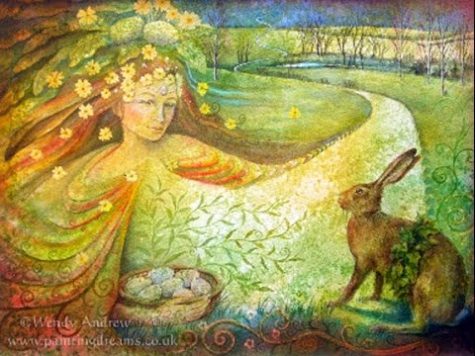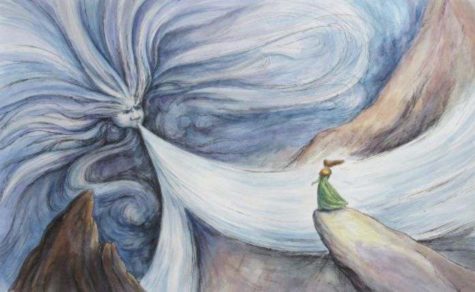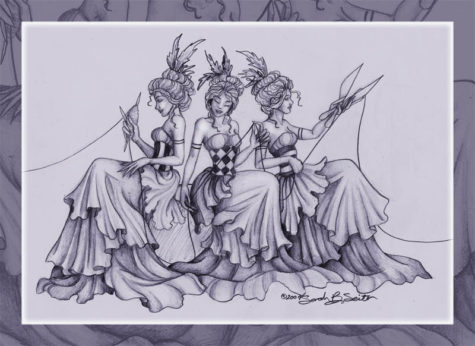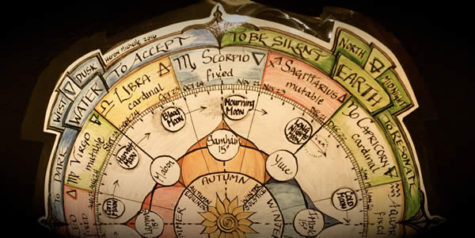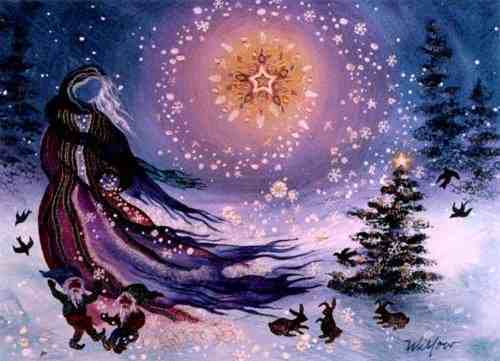Ritual Magick
For this ritual, you’ll want to decorate your altar with symbols of the season. Think about all the colors you see in nature at this time of year — bright daffodils, crocuses, plump tulips, green shoots — and incorporate them into your altar. This is also a time of fertility in the natural world — the egg is the perfect representation of this aspect of the season. Symbols of young animals such as lambs, chicks, and calves are also great altar adornments for Ostara.
In addition, you’ll need the following:
- Three candles — one yellow, one green, and one purple
- A bowl of milk
- A small bowl of honey or sugar
Perform this ritual outside if at all possible, in the early morning as the sun rises. It’s spring, so it may be a bit chilly, but it’s a good time to reconnect with the earth. If your tradition normally requires you to cast a circle, do so now.
Begin by taking a moment to focus on the air around you. Inhale deeply, and see if you can smell the change in the seasons. Depending on where you live, the air may have an earthy aroma, or a rainy one, or even smell like green grass. Sense the shift in energy as the Wheel of the Year has turned.
Light the green candle, to symbolize the blossoming earth. As you light it, say:
The Wheel of the Year turns once more,
and the vernal equinox arrives.
Light and dark are equal,
and the soil begins to change.
The earth awakes from its slumber,
and new life springs forth once more.
Next, light the yellow candle, representing the sun. As you do so, say:
The sun draws ever closer to us,
greeting the earth with its welcoming rays.
Light and dark are equal,
and the sky fills with light and warmth.
The sun warms the land beneath our feet,
and gives life to all in its path.
Finally, light the purple candle. This one represents the Divine in our lives — whether you call it a god or a goddess, whether you identify it by name or simply as a universal life force, this is the candle which stands for all the things we do not know, all those things we cannot understand, but that are the sacred in our daily lives. As you light this candle, focus on the Divine around and within you. Say:
Spring has come! For this, we are thankful!
The Divine is present all around,
in the cool fall of a rain storm,
in the tiny buds of a flower,
in the down of a newborn chick,
in the fertile fields waiting to be planted,
in the sky above us,
and in the earth below us.
We thank the universe* for all it has to offer us,
and are so blessed to be alive on this day.
Welcome, life! Welcome, light! Welcome, spring!
Take a moment and meditate on the three flames before you and what they symbolize. Consider your own place within these three things — the earth, the sun, and the Divine. How do you fit into the grand scheme of things? How do you find balance between light and dark in your own life?
Finally, blend the milk and honey together, mixing gently. Pour it onto the ground around your altar space as an offering to the earth. As you do, you may wish to say something like:
I make this offering to the earth,
As thanks for the many blessings I have received,
And those I shall some day receive.
Once you have made your offering, stand for a minute facing your altar. Feel the cool earth beneath your feet, and the sun on your face. Take in every sensation of this moment, and know that you are in a perfect place of balance between light and dark, winter and summer, warmth and cold — a time of polarity and harmony.
When you are ready, end the ritual.
Tips:
- Instead of “the Universe”, feel free to insert the name of your patron deity or the gods of your tradition here.
- If you’re doing this rite indoors, take your bowl of milk and honey and pour it in your garden, or around your yard.
Source: paganwiccan
- Colors: White, grey and black
- Element: Air
- Daily Meal: Raw cold food.
- Song: Wind’s Four Quarters
Altar: On cloth of shades between white and black, place four white and grey candles, a vase of flags and banners in the colors of a snowy night, a bell with a clear tone, a knife, a glass of white wine, and incense of cypress and juniper.
Offerings: Blowing curls of paper into the wind. Ringing bells or wind chimes. Study and learning, especially of a field of knowledge that is difficult for you.
Invocation to the North Wind
Breathe in!
Breathe in the wind of the North,
Cold and chill,
Ice-flecked wind that brings
The order for all life to sleep,
Forcing closed our tired eyes,
Wind that sweeps down from the poles,
Wind that sweeps away our resistance,
Wind that invites us to lie down
And embrace the darkness,
Whistling wind that comes in
Through the cracks and chinks
Of our fears and longings,
Breath of winter, wind that strokes the starry skies
Over the dead fields, and calls to us
With sere and weathered voice,
Black wind of night that cuts us
Like the razor-edged knife,
Have mercy on us!
Breathe in
And cleanse your body yet again.
Chant:
Boreas Boreas Breath of the North
Wind of knives
Wind chimes and bells are rung. Wine is poured as a libation. All process outside and release messages on small curls of paper into the north wind.
From: Pagan Book of Hours
The Festival of Janus, or The Agonalia, was held in Ancient Rome on or around January 9th. Here is a ritual to celebrate the God of doorways, openings, and beginnings.
- Color: Dark Blue and Black
- Element: Air
- Altar: Upon cloth of dark blue and black place a ruler, and on one side things of the past, and on the other side things for the future, including a goblet of wine.
- Offerings: Measure something accurately. Any work requiring measuring is honored today.
- Daily Meal: Any old-fashioned recipe.
Invocation to Janus
Hail, Lord Who Looks Both Ways!
Hail, face of the past
Turned towards memory!
You see all that has been,
Not only our beginnings,
But our past deeds
Which have brought us to this day.
May we learn to take responsibility for them.
Hail, face of the future
Turned towards possibility!
You see all that might be,
A multitude of choices,
Yet that multitude is pruned
Back to a likely few
By the deeds of the past.
Hail, Lord who stands at the boundary
Of then and now, of there and here.
We stand also at that boundary.
Teach us to see how the past
Shapes the future in its hands,
That we may not be blind to our own divinity.
Chant:
Measure the line
With memory
Stand on the line
Of possibility
(Pour out the libation of wine and exit. Work today should concentrate on making or mending things. See especially to fences and gates. Planning for future events is also acceptable.)
Found at: Pagan Book of Hours
Here is a nice ritual to invoke favor from Weavers of Fate, the Moerae. It is particularly appropriate for birthdays, the New Year, the Kalends of January, or any day of significance and change. The Moerae (or Moirai) were supposed to appear three nights after a child’s birth to determine the course of its life, so this too would be an appropriate time for this ritual.
Who are they?
The Moerae are the three sisters who decide on human fate: Clotho, Lachesis, and Atropus. They sing in unison with the music of the Sirens, or so it is said. Lachesis sings of the things that were, Clotho of those that are, and Atropus about the things that will be. They are most honored among the gods because they distribute justly, and have a share in every home. They give men at their birth their share of evil and good, and they punish the transgressions of both men and of gods.
- Lachesis (the past): the apportioner of lots.
- Clotho (the present): is the spinner.
- Atropus (the future): is said to be the eldest, the best and the shortest of the sisters.
It has also been claimed that Tyche (Fortune) was one of the Moerae, and the most powerful of the sisters because beauty, virtue, and good Fame are in her keeping, and also because she finds pleasure in dashing immoderate hopes.
The Ritual
Colors: White, red, and black.
Element: Air
Altar: Drape with cloths of white, red, and black, and place upon it three candles in these same colors, three goblets in these same colors holding white wine, red wine, and elderberry wine, a spindle wound with handspun thread, a piece of woven cloth, and a large knife or pair of shears.
Offerings: Libations of wine.
Daily Meal: Vegan. Should be eaten in silence.
Invocation to the Moerae
(Light the white candle and raise the spindle.)
Spin truth into words,
Spin words into doom,
Spin doom into fortune,
Spin fortune into life,
Spin my life fine and strong,
O Lady with the spindle
Whose thread is my beginning.
(All take a piece of thread from the spindle. Pour out the white wine as a libation. Light the red candle and lift the woven cloth high.)
Weave truth into vision,
Weave vision into mind,
Weave mind into spirit,
Weave spirit into life,
Weave my life with depth and color,
O Lady with the shuttle
Whose tapestry is my existence.
(All knot their thread. Pour out the red wine. Light the black candle and lift the shears high.)
Cut truth away from falsehood,
Cut falsehood away from illusion,
Cut illusion away from matter,
Cut matter away from body,
Cut my body away from my life
When the time comes,
O Lady with the shears
Whose knowing hand is my doom
And also my truth.
(The leader of the ritual drapes his or her head with a cloth of black and walks around the circle, cutting each thread in silence. The cut threads are laid upon the altar as an offering, and all sit in silence, meditating on their Fate and that of the coming year. Leave in silence.)
From: Pagan Book of Hours
The following is of archaic Celtic origin. On the surface it is a triple recital of the thirteen months of the lunar year. Each word, however, is the name of one of the sacred trees, which in turn each have deep philosophical and magickal implications. Additionally, the thirteen, taken in sequence, tell in rich detail the life of the Sacred King and the archaic Legend of the Goddess.
All Witches should know or be strongly encouraged to study and research the hidden meanings behind this, working from the material provided by the poet Robert Graves (The White Goddess) .
Very powerful when done as a group, this chant can be done by the solitary practitioner as well. Provided here are the instructions for a group ritual, which can then be adjusted to suit an individual practice.
Prior to commencing the chant, everyone gathers in the circle, with the implications of the chant being described by whoever is leading the ritual. Pause in silence for a period of thirteen heartbeats while everyone meditates on what has been said, then the leader of the ritual intones the words of the chant loudly and in a rich voice. The chant is recited with all in the circle responding, three or nine times, as deemed appropriate. The chant is closed with the final invocation. If available, incense may be thrown into an incense brazier at the close of the chant. Everyone should remain silent for a while afterwords.
Here is the chant, which is repeated by all in the circle, slowly, and sounding each letter long and resonantly:
BETH
LUIS
NION
FEARN
SAILLE
UATH
DUIR
TINNE
COLL
MIN
GORT
PETH
RUIS
Repeat three or nine times as desired. I personally like the idea of repeating each individual name three times, and then repeating the entire sequence three times (which adds up to nine).
The leader of the circle closes with the following calling:
Benignissime
Solo Tibi Cordis,
Devotionem
Quotidianam Facio,
Blessed Be!
From: A Grimoire of Shadows
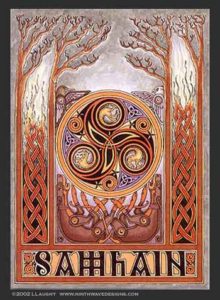 Place upon the altar apples, pomegranates, pumpkins, squashes and other late autumn fruits. Autumn flowers such as marigolds and chrysanthemums are fine too. Write on a piece of paper an aspect of your life which you wish to be free of: anger, a baneful habit, misplaced feelings, disease. The cauldron or some similar tool must be present before the altar as well, on a trivet or some other heat-proof surface (if the legs aren’t long enough). A small, flat dish marked with an eight-spoked wheel symbol should also be there.
Place upon the altar apples, pomegranates, pumpkins, squashes and other late autumn fruits. Autumn flowers such as marigolds and chrysanthemums are fine too. Write on a piece of paper an aspect of your life which you wish to be free of: anger, a baneful habit, misplaced feelings, disease. The cauldron or some similar tool must be present before the altar as well, on a trivet or some other heat-proof surface (if the legs aren’t long enough). A small, flat dish marked with an eight-spoked wheel symbol should also be there.
Prior to the ritual, sit quietly and think of friends and loved ones who have passed away. Do not despair. Know that they have gone on to greater things. Keep firmly in mind that the physical isn’t the absolute reality, and that souls never die.
Arrange the altar, light the candles and censer, and cast the Circle of Stones. Recite a Blessing Chant, and invoke the Goddess and God in any way that feels right to you.
Lift one of the pomegranates and, with your freshly-washed white-handled knife, pierce the skin of the fruit. Remove several seeds and place them on the wheel-marked dish. Raise your wand, face the altar and say:
On this night of Samhain I mark your passing,
O Sun King, through the sunset into the Land of the Young.
I mark also the passing of all who have gone before,
and all who will go after. O Gracious Goddess,
Eternal Mother, You who gives birth to the fallen,
teach me to know that in the time of the greatest
darkness there is the greatest light.
Taste the pomegranate seeds; burst them with your teeth and savor their, bittersweet flavor. Look down at the eight-spooked symbol on the plate; the wheel of the year, the cycle of the seasons, the end and beginning of all creation.
Light a fire within the cauldron (a candle is fine). Sit before it holding the piece of paper, gazing at its flames. Say:
Wise One of the Waning Moon,
Goddess of the starry night,
I create this fire within your cauldron
to transform that which is plaguing me.
May the energies be reversed:
From darkness, light!
From bane, good!
From death, birth!
Light the paper in the cauldron’s flame and drop it inside. As it burns, know that your ill diminishes, lessens and finally leaves you as it is consumed within the universal fires.
If you wish, you may attempt scrying or some other form of divination, for this is a perfect time to look into the past or future. Try to recall past lives too, if you will. But leave the dead in peace. Honor them with your memories but do not call them to you. Release any pain and sense of loss you may feel into the cauldron’s flames.
Works of magic, if necessary, may follow. Celebrate the Simple Feast. The circle is released.
From SimpleMagick.com
Note: More information can be found here – Samhain (A post on The Pagan Calendar)
- Invocation to the Archangels as a Group by shirleytwofeathers - No Comment
- Invocation to Lord Melchizedek by shirleytwofeathers - No Comment
- Connecting with Fairies by shirleytwofeathers - No Comment
- To Enhance Clairvoyance by shirleytwofeathers - No Comment
- For Release of Addictions and Cravings by shirleytwofeathers - No Comment
- Using the Psalms for Solving Problems by shirleytwofeathers - 148 Comments
- Spiritual Assistance Spell by shirleytwofeathers - 35 Comments
- 62 Spells To Defeat Your Enemies by shirleytwofeathers - 27 Comments
- Once In A Blue Moon Spell by shirleytwofeathers - 24 Comments
- Spell To Find A Lost Pet by shirleytwofeathers - 12 Comments
Mauro: Ritual To Become A Werewolf
Mauro: Becoming A Werewolf Ritual
Janet Silva: Wheel of Fortune Change Your Luck Spell
Linda: Sweet Thoughts Bottle Spell
AnnD: Chant For Guidance
